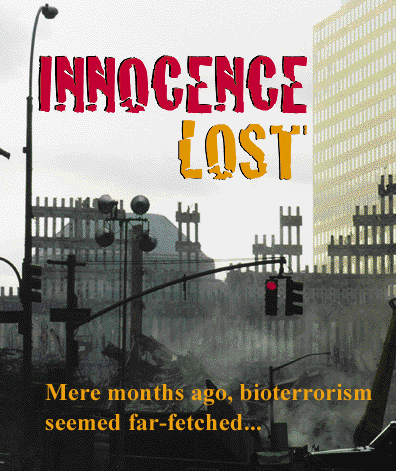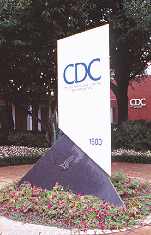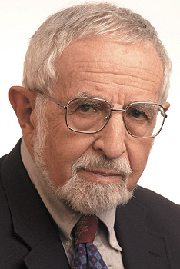As Stan Foster considers the possibility of bioterrorists unleashing smallpox upon an unvaccinated world, his thoughts travel back to 1975, to a desperately ill Bangladeshi girl named Rahima Banu, 3 years old and covered with painful pox. “We found her hidden under a burlap sack,” he says. “Hers was the last case of variola major seen in the world. Luckily, she survived.” A few years ago, he traveled with a BBC film crew to her village to meet her, her husband, and her two young daughters. It was a joyous celebration, a time to look back and celebrate the eradication of smallpox, a public health victory that required the astronomical efforts of thousands of people. He shudders to imagine terrorists turning back the clock to the days when smallpox raged. “We must realize that a bioterrorist attack on the United States using smallpox would reintroduce the virus into the world,” says Foster, RSPH professor of International Health. “Here, we have the facilities and vaccine to control it. But should it get back into previously endemic areas, it would be especially tragic. We could see possibly 100 million cases and 10 million deaths.”
These days, Foster spends much of his time teaching federal, state, and local health officials and clinicians the intricacies of smallpox diagnosis. He and RSPH Presidential Distinguished Professor of International Health William Foege are among a small number of physicians nationwide who know from experience—not just pictures—what smallpox looks like.
Defensive measures That threat became reality when letters filled with weapons-grade anthrax shut down the US Congress, sickened more than a dozen people, killed five, and started 20,000 potentially exposed people on preventive antibiotics. As the crisis unfolded, the Institute of Medicine (IOM), the Association of American Medical Colleges, the American Public Health Association, and the American Association for the Advancement of Science called upon scientists, physicians, and public health workers to lend their brainpower to the national effort to counter terrorism. Long before September 11, many faculty members at the Rollins School of Public Health were quietly working on issues relating to bioterrorism. A phone call from a member of the Rollins family, longtime benefactors of the school, put their efforts on a fast track. A simple question, “How can we help?” became the impetus for a $4.2 million gift from the O. Wayne and Grace Crum Rollins Foundation to establish the RSPH Center of Public Health Preparedness and Research. Recently named a national CDC center for public health preparedness, the RSPH center will give structure and focus to ongoing work relating to terrorism prevention and preparedness as well as emerging infectious disease surveillance. It will encourage collaborations across the Emory campus and with local health agencies, the Georgia Division of Public Health, CDC, and organizations working globally to reduce the threat. The Rollins’s gift was a natural way for the family to help out during a time of crisis, says Amy Rollins Kreisler, executive director of the Rollins Foundation. “Like so many people after September 11, our family felt the need to help,” she says. “Helping the school prepare future public health leaders for such unprecedented public health challenges will make the world a safer place for everybody, including our children and grandchildren.”
“We must support efforts at deterrence both locally and globally, but we can not assure their success,” she says. “Biologic weapons are easy to develop and easy to hide. Bioterrorism has proven to be a real threat and may occur with far more severe consequences than we have yet witnessed.”
Shoring up the nation’s flagging public health system is a mammoth undertaking. But RSPH is ramping up efforts already under way to train public health workers in the field, MPH and medical students in the classroom, and doctors and nurses in hospitals, clinics, and private practice about infectious disease surveillance. Faculty will continue their close work with CDC, state and local health departments, and other government agencies on preparedness issues. Indeed, several RSPH faculty members played crucial roles in containing the anthrax crisis and continue to work on issues related to bioterrorism, says Dean James Curran. David Stephens, director of the Division of Infectious Diseases in the Emory School of Medicine and professor of epidemiology at RSPH, directed CDC’s clinical team during the anthrax outbreak. Professor of International Health Keith Klugman recently tested a new class of drugs against antibiotic-resistant strains of anthrax. Biostatisticians Ira Longini and Elizabeth Halloran are adapting long-used statistical models of influenza outbreaks to map the distribution and trajectory of smallpox outbreaks in various scenarios. Their results should help the National Institutes of Health prepare vaccination and quarantine strategies to prepare for bioterrorist smallpox attacks. For scientific expertise on anthrax, the national press turned to Philip Brachman, professor of international health and retired CDC epidemiologist. In 1957, he investigated the only other inhalational anthrax epidemic in US history. During the recent epidemic, his frank opinions and expert advice on human anthrax infections were quoted almost daily. “Schools of public health have an obligation to alert and educate the public,” says Brachman. “We may not prevent bioterrorism—the first indication of any bioterroristic event is that it happens—but how we react can stop too many lives from being destroyed.” Recent events have transformed the nation’s psyche, and public health priorities have changed along with it, says Curran. “We are living in a time when a far-off threat now seems imminent. We’re learning new things every day, and one thing we’ve learned is that bioterrorism can work using anthrax. We have been in the midst of a national public health crisis, and Emory’s faculty and our CDC colleagues have done yeoman’s work under incredible pressure and indeed some threat to their own lives. I am proud to say that our faculty stepped up to the plate when they were needed.”
An invisible threat
When disaster stikes
Resisting anthrax
Spring
2002 Issue |
Dean's Message | In
Brief | Innocence Lost | Copyright © Emory University, 2002. All Rights Reserved. Send comments to hsnews@emory.edu. |





